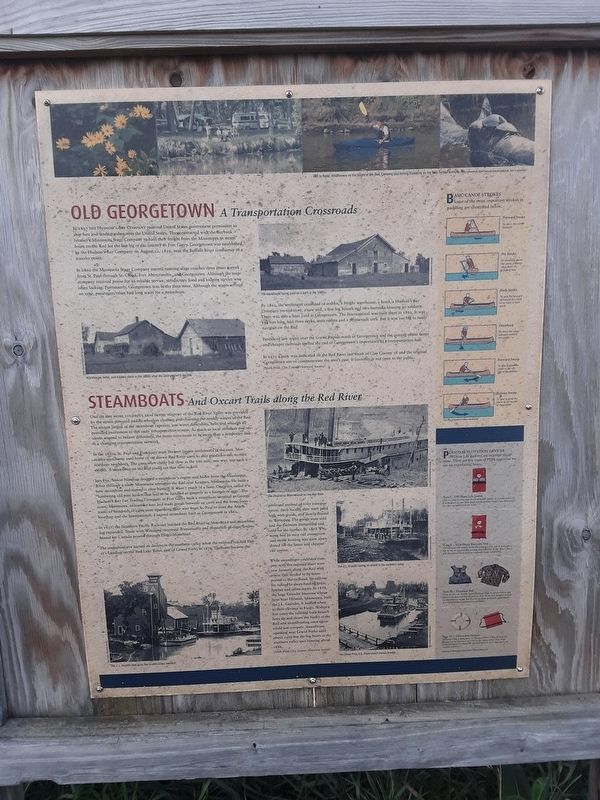Georgetown in Clay County, Minnesota — The American Midwest (Upper Plains)
Old Georgetown Steamboats
Old Georgetown
A Tranportation Crossroads
In 1857 the Hudson's Bay Company received United States government permission to ship furs and trade goods across the United States. They contracted with the Burbank brother's Minnesota Stage Company to haul their freight from the Mississippi to steam boats on the Red for the last leg of the journey to Fort Garry, Georgetown was established by the Hudson's Bay Company on August 12, 1859, near the Buffalo River confluence as a transfer point.
In 1860 the Minnesota Stage Company started running stage coaches three times a week, from St. Paul through St. Cloud, Fort Abercrombie, and Georgetown. Although the stage company received praise for its reliable service, satisfactory food and lodging service was often lacking. Fortunately, Georgetown was better than most. Although the stages arrived on time, passengers often had long waits for a steamboat.
By 1862, the settlement consisted of stables, a freight warehouse, a hotel, a Hudson's Bay Company owned store, a saw mill, a few log houses and two barracks housing 30 soldiers. There was also a boat yard at Georgetown. The International was built there in 1862, It was 134 feet long, had three decks, state rooms and a promenade area. But it was too big to easily navigate on the Red.
Periods of low water over the Goose Rapids north of Georgetown and the coming of the faste and cheaper railroads spelled the end of Georgetown's importance as a transportation hub.
In 1970 a park was dedicated on the Red River just south of Clay County 36 and the original Georgetown site to commemorate the area's past. It currently is not open to the public.
(Mark Peihl, Clay County Historical Society)
Steamboats
And Oxcart Trails Along the Red River
One of the more colorful eras in the history of the Red River Valley was provided by the steam powered paddle-wheelers chuffing and churning the muddy waters of the Red: The arcane jargon of the steamboat captains, low water difficulties, bells and whistles all provided excitement to this early transportation system. As much as local investors and residents wanted to believe differently, the boats were never to be more than a temporary link in a changing transportation network.
In the 1850s, St. Paul and Fort Gary were the two largest settlements in the area. Minnesota merchants used horse or ox drawn Red River carts to ship goods for sale to their northern neighbors, The carts were cheap but slow as the soo mile, one way, trip took a ntooth. A steamboat on the Red could cut that time in half.
In 1859, Samson Northup dragged a steamboat's engine and boiler from the Mississippi River through a nasty Minnesota winter to the Red near Kragnes, Minnesota. He built a new steamboat and named it after himself. It wasn't much of a boat. One pilot called it a "lumbering old pine basket that had to be handled as gingerly as a hamper of eggs". The Hudson's Bay Fur Trading Company at Fort Garry buik a steamboat terminal at Georgetown, Minnesota, to transfer furs and trade goods between ox carts and the boat, Soon trains of hundreds of carts were squeaking deir way from St. Paul to meet the Anson Northup and the International, a second steamboat built at Georgetown in 1862, In 1871, the Northern Pacific Railroad reached the Red River at Moorhead and steamboat. ing expanded. Trade with Winnipeg increased dramatically and thousands of eager settlers bound for Canada poured through Pargo-Moorhead. The steamboat era started its decline in the southern valley when the railroad reached Fisher's Landing on the Red Lake River, east of Grand Forks in 1876. Flatboats became the preferred method of river transportation. Built locally, they were piled high with goods, and slowly floated to Winnipeg. The goods were sold and the flatboats dismantled and sold for the lumber. By 1878 Win nipeg had its own rail connection and steain boating was soon abandoned for the faster and cheaper rail system.
While steamboats could not compete with the railroad there were new farmers along the Red with wheat that needed to be transported to the railhead. Steamboaters turned to short-hauling grain, timber and other wares. In 1878, the huge Grandin bonanza wheat farm hear Halstad, Minnesota, built the J.L. Grandin. It hauled wheat to their elevator in Fargo. Within a few years the railroad built branch lines up and down the banks of the Red and steamboating once again could not compete. Steamboats operated near Grand Forks until about 1910 but the big boats in the southern valley quit running about 1886.
(Mark Peihl, Clay County Historical Society).
Topics. This historical marker is listed in these topic lists: Industry & Commerce • Settlements & Settlers • Waterways & Vessels. A significant historical date for this entry is August 12, 1859.
Location. 47° 5.548′ N, 96° 48.917′ W. Marker is in Georgetown, Minnesota, in Clay County. Marker is on County Highway 36, on the left when traveling west. Touch for map. Marker is in this post office area: Georgetown MN 56546, United States of America. Touch for directions.
Also see . . . Site History. (Submitted on September 8, 2022, by Tucker Lutter of Barnesville, Minnesota.)
Credits. This page was last revised on February 25, 2023. It was originally submitted on September 8, 2022, by Tucker Lutter of Barnesville, Minnesota. This page has been viewed 158 times since then and 45 times this year. Photo 1. submitted on September 8, 2022, by Tucker Lutter of Barnesville, Minnesota. • J. Makali Bruton was the editor who published this page.
Editor’s want-list for this marker. A wide view photo of the marker and the surrounding area together in context. • Can you help?
